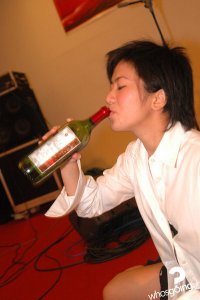Portland, Ore. -- Speaking in front of a packed room at the Oregon Convention Center on Thursday, Robert Steinhauer reflected upon the changes he's seen since first entering the wine industry 40 years ago. Honored by the American Society for Enology and Viticulture (ASEV) as the recipient of its 2008 Merit Award, the noted grower said that during the past several decades an influx of new people changed Napa Valley, bringing in money and different life experiences that changed the area and the way wine is made there. He said that if the industry is going to continue to evolve and thrive, more money must be invested in research--both to increase quality and fight the pests that threaten crops.
As a recent graduate of the master's program at California State University, Fresno, Steinhauer had managed a 5,000-acre vineyard near Delano, Calif., in the southern Central Valley, where he was involved in negotiating a union contract with vineyard laborers. In the 1970s, at the urging of his wife, Verna, Steinhauer took a job in the Napa Valley, working for Beaulieu Vineyard under Andy Beckstoffer, who is now renowned as one of the biggest private vineyard owners in Napa Valley. Steinhauer also worked with Andre Tchelistcheff, the Russian-born, French-trained enologist who directed winemaking at Beaulieu for several decades. One of the longest-lasting lessons Tchelistcheff gave Steinhauer was the importance of site selection--the grape variety must be matched to the appropriate site to make high-quality wine. This was a new concept at the time for many California wineries, which sometimes planted Grey Riesling beside Zinfandel beside Cabernet Sauvignon and Napa Gamay.
In 1979, Steinhauer began a 25-year career with Beringer Vineyards, a once-sleepy, 100-year-old Napa Valley winery that was then newly owned by the Nestle company of Switzerland. Steinhauer's tenure as Beringer vineyard manager coincided with the winery's growth from about 1 million cases annually to 10 million, he said.
"I kept saying to everyone that we can be good, and we can be big, too," Steinhauer recalled. He began a collaboration with Beringer winemaster Myron Nightingale and, later, his successor, Ed Sbragia, that enabled Beringer simultaneously to become one of the top White Zinfandel brands in California and also the maker of Beringer Private Reserve Chardonnay and Cabernet Sauvignon, both of which won the highest accolades from wine critics. For Beringer, Steinhauer expanded vineyards beyond the Napa Valley floor to Howell Mountain, to Knights Valley in Sonoma County, and to large vineyard developments in California's Central Coast.
Technology
Much as the new residents changed the Napa Valley's growing and winemaking traditions, the technology changed as well, Steinhauer said.
Drip irrigation--When Steinhauer began his career in the Central Valley, vineyards were flood-irrigated. Drip irrigation used much less water and made it easier to irrigate remote and hillside vineyards.
Mechanical harvesting--As far back as 1990, Steinhauer and staff did a comparative study of machine-harvested versus hand-harvested fruit. "It was proven out to be a good tool," he said. In a blind tasting of the resulting wines, the winemakers trying them could detect a difference, but they did not agree on a preference for one or the other.
Clean stock program--Steinhauer began his career at a time when leafroll disease and fanleaf virus infected hundreds of acres of vineyards and held back wine quality. A program to certify disease-free nursery stock was a boon for the industry, he said.
Chardonnay--The grower estimated that Chardonnay plantings in California have increased from 5,000 acres to 95,000 acres during his career, and he noted that improvements in viticulture produced increases in yields from 1.5 tons per acre in Napa Valley in the 1970s to 4 tons today.
Pinot Noir clones, and clonal selection availability for other varieties--Few options were available to growers in Steinhauer's early career, but he noted that the introduction of the Pommard clone, Beaujolais clones and, later, the Dijon clones, transformed California and Oregon Pinot Noir.
Phylloxera--In 1985, he first heard that a vineyard in Napa Valley was declining because of the infamous grapevine louse, phylloxera. "I had been a big fan of the AxR-1 rootstock," Steinhauer said, "and I was in the camp that said it will not be susceptible to phylloxera." Beringer had planted hundreds if not thousands of acres on this rootstock, known historically to have some susceptibility to phylloxera. "It was a $40 million mistake for Beringer," Steinhauer admitted, but as he directed the replanting of failing vineyards, many new viticultural improvements were implemented, including vertical shoot positioning of the vines, row orientation north and south, and other steps that "improved the wine quality by leaps and bounds."
Vine protection--Drip irrigation is nearly universal now, he observed, and many Napa Valley vineyards also install overhead sprinklers or wind machines for frost protection. Now, some growers have added water misters to cool the vines during heat spikes.
Filtered light--Early in his career, the California sprawl was a common vine-training design, which kept most of the fruit shaded by the canopy. Then in the 1980s and 1990s, canopies were stretched up and away from the fruit zone to allow sunlight on the berries. The next wave of research, however, showed that too much direct sun on the grapes is not good for wine quality, so the concept of a canopy that allows dappled light on the bunches is now preferred.
Sustainability--Steinhauer said he's proud that growers and vintners established the California Sustainable Winegrowing Alliance and promoted sustainable winegrowing guidelines for growers. He's happy with how far the program has progressed since early this decade, but said, "We've got to step back and find a way to certify this sustainability so the consumer knows he or she is getting a quality, responsible product."
Challenges
Reflecting on the biggest challenges he faced as a grapegrower, Steinhauer recalled a trip to South Africa that he took with his Beringer teammate Tom Peterson and others. "I remember we were touring the vineyards, and Tom was afraid of the snakes, the puff adders and black mambos. That night at dinner, I asked the South African growers hosting us what their biggest problem in the vineyard was, and one said, 'Oh, the winemaker.' So that's universal," he quipped.
Pierce's disease and glassy-winged sharpshooter--Steinhauer said he was shocked to see the extent of damage in Temecula vineyards from Pierce's disease when he visited at the height of the infestation. "We have blue-green sharpshooters in Napa Valley, but you rarely see two or three at a time. In Temecula they were flying around us by the thousands." He said the industry had risen to the challenge of finding ways to defeat the sharpshooters through research.
Leafroll disease--Steinhauer mentioned the recent sighting of light brown apple moths in California as a potential threat, but added that vine mealybug and the recent fast spread of leafroll disease in Napa Valley vineyards are his biggest concerns. Believed to be the vector of the viruses that cause leafroll disease, the vine mealybug came in a suitcase on table grapes from the Mediterannean region to the Coachella Valley of California, according to Steinhauer, who said he saw the proof. "Leafroll is spreading very rapidly in Napa Valley," he said. "Believe me, this is extremely important. For some of us, it's as big a threat as phylloxera; but with leafroll, there is no known control, while with phylloxera there was," he said, referring to replanting on resistant rootstocks.
Climate change--Winegrowers need to accept that climate change is happening, and adapt to it, he said.
More challenges--The wine industry should find ways to make wines with the tannins and flavor of the current high-alcohol wines, but without so much alcohol, Steinhauer said. Handling salt accumulation in the soil of the San Joaquin Valley is another major challenge, as is fanleaf disease.
Moving forward
Steinhauer, who has been very active on industry boards such as the American Vineyard Foundation and the Unified Wine & Grape Symposium program committee, urged other members of the ASEV to support these and other industry associations at the local, state and national levels.
Finally, Steinhauer called for more research for the American wine industry to compete more effectively against its rivals. He acknowledged the work so far by the American Vineyard Foundation and National Grape & Wine Initiative, but said, "I challenge you to raise more money, a lot more money, for research. You might say that we're on the right track, that we're making progress, but as Will Rogers said, 'You can be sitting on the right track and still get run over.'"
Jim Gordon
skip to main |
skip to sidebar
Enhance the pleasure that you get from wine by sharing your experiences, knowledge, news articles and facts about the elixir of the gods and bacchanalia on earth by emailing: bacchusforyou@bellsouth.net
How Much Did The Best Bottle of Wine You Ever Drank Cost?
CONTACT INFORMATION
TO SUBMIT A POST, TO BE PUT ON THE MAILING LIST, TO HAVE QUESTIONS ANSWERED, ETC.
EMAIL:



